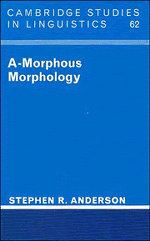Book contents
- Frontmatter
- Contents
- Acknowledgments
- Introduction
- 1 The study of word structure
- 2 Why have a morphology at all?
- 3 Is morphology really about morphemes?
- 4 The interaction of morphology and syntax
- 5 The theory of inflection
- 6 Some complex inflectional systems
- 7 Morphology in the lexicon: derivation
- 8 Clitics are phrasal affixes
- 9 The relation of morphology to phonology
- 10 How much structure do words have?
- 11 Composites: words with internal structure
- 12 Morphology and the typology of languages
- 13 Morphological change
- 14 Morphology as a computational problem
- References
- Index
13 - Morphological change
Published online by Cambridge University Press: 10 January 2011
- Frontmatter
- Contents
- Acknowledgments
- Introduction
- 1 The study of word structure
- 2 Why have a morphology at all?
- 3 Is morphology really about morphemes?
- 4 The interaction of morphology and syntax
- 5 The theory of inflection
- 6 Some complex inflectional systems
- 7 Morphology in the lexicon: derivation
- 8 Clitics are phrasal affixes
- 9 The relation of morphology to phonology
- 10 How much structure do words have?
- 11 Composites: words with internal structure
- 12 Morphology and the typology of languages
- 13 Morphological change
- 14 Morphology as a computational problem
- References
- Index
Summary
Only a few years ago, Lightfoot (1979) could correctly note that most of what passes for the study of syntactic change in the literature of linguistics is really concerned with change in morphological rather than syntactic properties. As the opposite side of the same coin, much of the literature on phonological change is similarly devoted to essentially morphological problems. This state of affairs doubtless derives today from the early generative program of reducing word structure either to syntax or to phonology, but in any case, the revival of synchronic morphology as a viable object of enquiry calls for corresponding study of the nature of change in morphological systems.
The present chapter discusses some basic issues of change in morphological systems, in the context of the theory developed in this book. We begin with a short excursus on the role of the study of change in the development of a synchronic theory of word structure, arguing that an adequate theory of what structures are possible in natural languages probably cannot be provided on a purely synchronic basis. Rather, we must view “what there is” as the product of “what is possible” with the range of possible diachronic developments. Linguistic structures do not simply spring into existence ex nihilo: most linguistic forms and regularities are inherited either directly or through the lens of linguistic change from previous states of the language; or else borrowed from the systems of other languages.
- Type
- Chapter
- Information
- A-Morphous Morphology , pp. 336 - 372Publisher: Cambridge University PressPrint publication year: 1992



